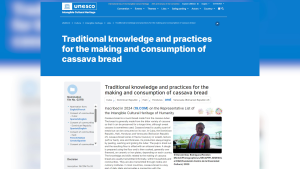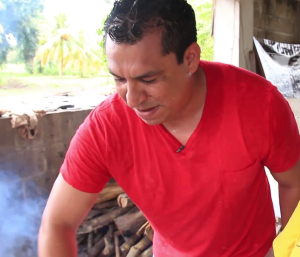Cassava Honored on UNESCO Cultural Heritage List
On Wednesday, UNESCO announced that cassava has been added to its list of humanity’s intangible cultural heritage. This list celebrates the rich diversity of cultural practices and knowledge from around the world, featuring over six hundred items from one hundred and forty countries. Cassava made the list thanks to a joint submission by Haiti, Venezuela, Honduras, and Cuba. Although Belize wasn’t part of the submission, the country has deep historical ties to cassava. Today, News Five’s Britney Gordon visited the Luba Garifuna Museum in Belize City to chat with Garifuna historian Sebastian Cayetano about the significance of cassava to Belize and the Garifuna people.
 Britney Gordon, Reporting
Britney Gordon, Reporting
Cassava has just been added to UNESCO’s cultural heritage list, celebrated for its historical significance in Haiti, Cuba, Venezuela, and Honduras. In Haiti, cassava is often used to make Attieke, a traditional side dish from Ivory Coast made with grated cassava pulp. But here in Belize, cassava brings its own unique and rich flavors, most famously used to make delicious cassava bread.

Sebastian Cayetano
Sebastian Cayetano, Garifuna Historian
“Cassava is the Garifuna staple and best of all, once the bread is baked, it can last 10 years. Yes, it can go ten years. The shelf life is ten years, once you keep it dry. Okay, and then from cassava, the root cassava, you can make lots, Garinagu are able to make a variety of food. We make the baked bread, cassava, we make cassava wine, we make cassava porridge, Sahul, is a great favorite. And then the same cassava, you make cassava dhani, we call it, that’s the cassava tamal, and lots of other things.”
Hanging proudly on the walls of the Luba Garifuna Museum in Belize City is a vibrant painting of a Garifuna woman preparing cassava bread. This masterpiece, created by the renowned Belizean artist and musician Pen Cayetano in 1983, captures a slice of Garifuna life. According to Garifuna historian and museum owner Sebastian Cayetano, this painting is a beautiful snapshot of the Garifuna experience.
 Sebastian Cayetano
Sebastian Cayetano
“This is a spatula. This is what you use to flip the cassava. It must not break. But it’s a huge cake, so it has to be, there’s an art in it. So you have to flip it once, and then flip it again, and then brush the side to remove the particles, and then you cut the edges, and then you have Ereba Cassava.”
Permanent UNESCO delegate to the Ivory Coast, Ramata Ly-Bakayoko, describes attieke as a fundamental dish in the rich culinary heritage of Ivory Coast, deeply woven into the daily lives of its people. Similarly, for the Garifuna people of Belize, making cassava bread is a communal activity. From gathering the root vegetable to grating and straining it, each step is a shared experience that brings the community together.

Tilda Sabal
Tilda Sabal, Cassava Bread Maker
“This da bout two pounds of cassava.”

Sean Kuylen
Sean Kuylen, Chef
“You have to clean the comal. How do you call this again?”
Tilda Sabal
“Bessawa or a broom.”
Sean Kuylen
“No oil.”
 Tilda Sabal
Tilda Sabal
“No oil. Then I put the sibbiba in the comal and I have to spread it.”
Sean Kuylen
“How much a this you bake in a day?”
Tilda Sabal
“It all depends. Seventy-five.”
 Adding cassava consumption to the intangible cultural heritage list shines a light on the shared experiences of African descendants across different nations. Cayetano has seen firsthand how making cassava bread unites people, bringing them together in a beautiful, communal tradition.
Adding cassava consumption to the intangible cultural heritage list shines a light on the shared experiences of African descendants across different nations. Cayetano has seen firsthand how making cassava bread unites people, bringing them together in a beautiful, communal tradition.
 Sebastian Cayetano
Sebastian Cayetano
“When we reach home, we place the cassava on the floor and call the neighbors, invite the neighbors to come and help us peel the cassava. Once we peel it, then we wash it. After we wash it then we use this grater. This grater is one hundred years old. We would have about four ladies around. One on this side, one there, one here, and one on the other side. And then we greet cassava. And as we grate, we sing, we shush. Everything happens there.”
Britney Gordon for News Five.







Facebook Comments